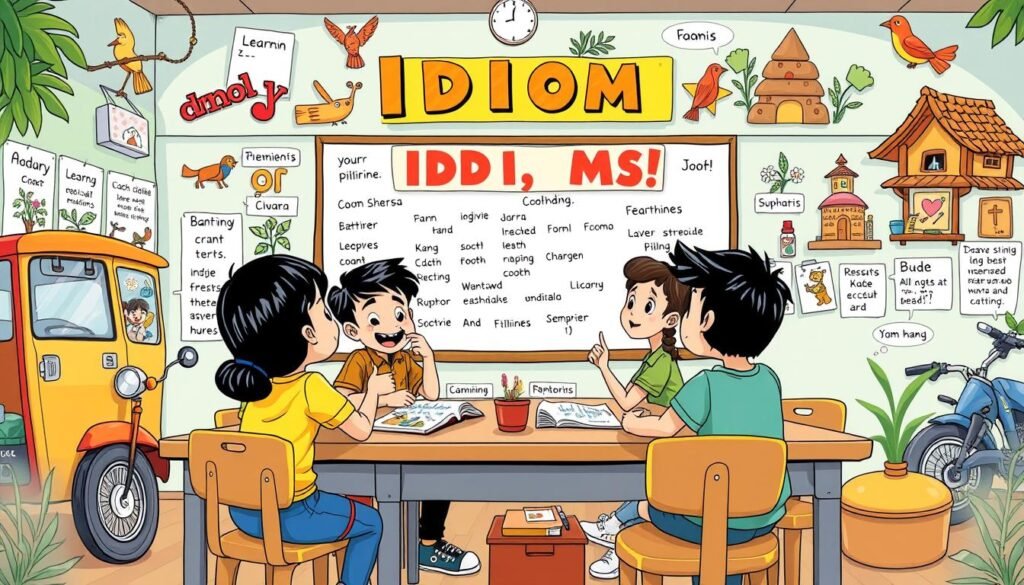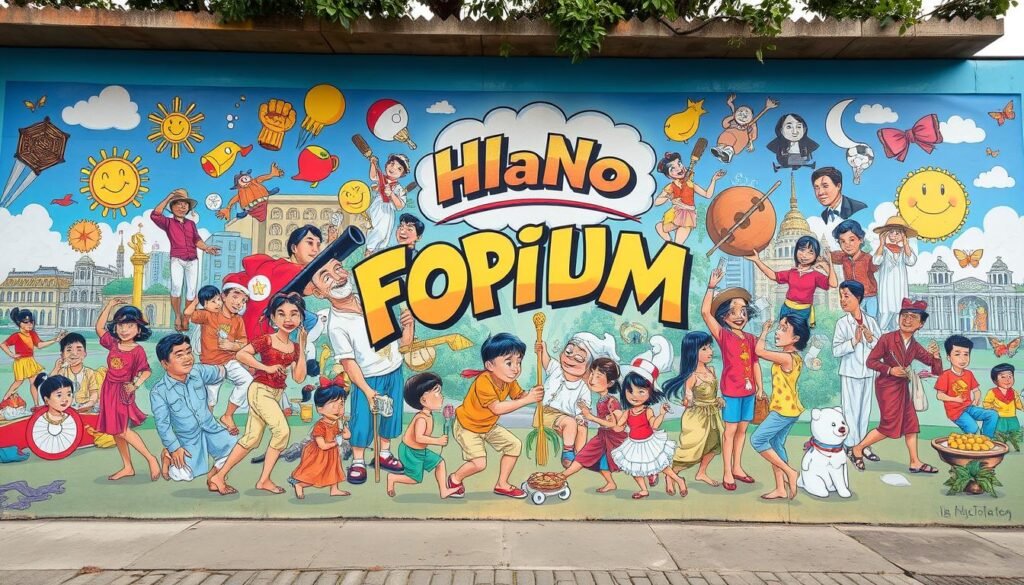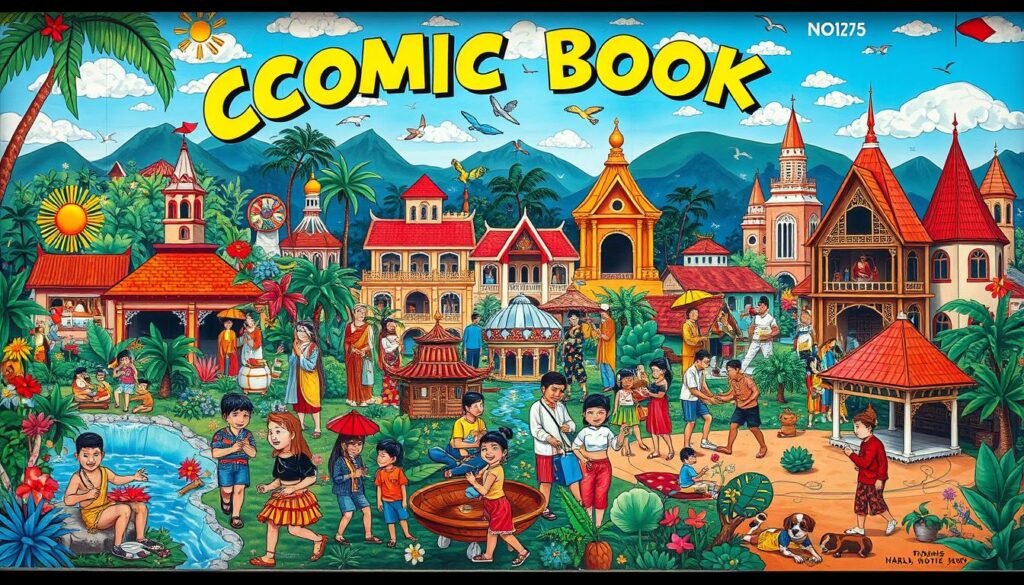What role do idioms play in shaping the cultural landscape of the Philippines? This country has over 7,000 islands, each with its own unique culture. Language and culture are deeply intertwined here.
The Philippines is famous for its hospitality. Guests are treated with warmth and generosity. This is reflected in the country’s language and culture. Idioms in the Philippines give us a glimpse into the country’s cultural diversity. They show how language shapes the nation’s identity.
Key Takeaways
- The Philippines is home to a diverse range of cultures, with language playing a key role in shaping the nation’s identity.
- Idioms are an essential part of the Filipino language, providing insight into the country’s cultural landscape and values.
- Understanding idioms is vital for effective communication and cultural respect in the Philippines.
- Idioms reflect the country’s history, customs, and traditions, making them an important part of Filipino culture.
- Language and culture are deeply intertwined in the Philippines, with idioms providing a unique perspective on the country’s cultural diversity.
The Importance of Idioms in Filipino Culture
Idioms are key in Filipino culture. They carry deep meanings and emotions tied to the country’s values. Expressions and sayings help share opinions without direct conflict, keeping harmony. For example, “bato-bato sa langit” shows the value of being resilient and adaptable.
Some important parts of Filipino idioms include:
- Conveying empathy and understanding through colorful imagery
- Reflecting cultural values such as humility, respect, and social hierarchy
- Enhancing conversations with nuanced meanings and diplomatic expressions
Research shows idioms are vital for effective communication. They reveal deep cultural beliefs and values. A study by Mirsad Suhodolli, in the International Journal of Advanced Research, highlights their role in learning vocabulary and understanding culture.
https://www.youtube.com/watch?v=roAxH1dZBf8
In summary, idioms are very important in Filipino culture. By using expressions and sayings, people can improve their communication. They can share complex ideas and show respect for the rich cultural heritage.
| Idiomatic Expression | Meaning |
|---|---|
| Bato-bato sa langit | Stones thrown up in the air, describing a situation where someone is taking a risk |
| Itaga mo sa bato | Carve it on stone, meaning to remember something forever |
Common Idioms Used in the Philippines
The Philippines is known for its rich language and culture. Its idioms show this diversity well. Many idioms use body parts, thanks to Spain’s influence. For instance, “Makati and dila” (Tsismosa o tsismoso) and “Ahas ulupong” (Taksil, traydor) are common. They highlight the unique cultural references in these sayings.
Other popular idioms include “Balat kalabaw” (Hindi nalalamigan), “Nagbibilang ng poste” (Walang trabaho), and “Hampaslupa” (Lagalag, busabos). These expressions are key in shaping how people talk and interact in the Philippines. They often express feelings that are hard to say directly, showing respect and avoiding offense.
Here are a few examples of Filipino idioms and their meanings:
- “Kapit tuko” (Mahigpit ang hawak) – to hold on tight
- “Bato-Bato sa Langit” – to throw stones at the sky
- “Itaga mo sa Bato” – to carve it on stone

These idioms cover a wide range of topics, from emotions and relationships to money and personal traits. They give us a glimpse into how idioms are used in the Filipino language and culture. The use of idioms like “Kapit tuko” shows their importance in daily talk. It shows how deeply rooted these sayings are in the Philippines’ culture.
| Idiom | Meaning |
|---|---|
| “Bato-Bato sa Langit” | to throw stones at the sky |
| “Itaga mo sa Bato” | to carve it on stone |
| “Iba na ang Kanto” | the street is different now |
Regional Variations of Idioms
The Philippines is a culturally diverse country. Its regional idioms show this diversity. Each region has its own expressions and sayings shaped by history, customs, and traditions.
In Luzon, you’ll find idioms like “Bato-Bato sa Langit” which means “stones thrown up in the air”. The Visayas region has “Itaga mo sa Bato” which means “write it on stone”. These idioms make the Filipino language richer and more complex.
Here are some examples of regional variations of idioms in the Philippines:
- Luzon: “Bato-Bato sa Langit”, “Itaga mo sa Bato”
- Visayas: “Itaga mo sa Bato”, “Iba na ang Kanto”
- Mindanao: “Mahalin mo ang kalikasan” which means “love nature”
These regional idioms show the Philippines’ cultural diversity. They also highlight the creativity and resourcefulness of the Filipino people. By understanding these variations, we can learn more about Filipino culture and language.
| Region | Idiom | Meaning |
|---|---|---|
| Luzon | “Bato-Bato sa Langit” | “stones thrown up in the air” |
| Visayas | “Itaga mo sa Bato” | “write it on stone” |
| Mindanao | “Mahalin mo ang kalikasan” | “love nature” |
The Influence of Indigenous Languages
The Philippines is rich in indigenous languages, adding to its cultural heritage. The carabao, the national animal, stands for strength and hard work. These values are deeply rooted in Filipino language and culture.
Indigenous languages have shaped the country’s sayings and expressions. They’ve made the Filipino language unique. For instance, metaphors and proverbs from these languages are now part of daily talks. This shows the culture‘s creativity and expression.
Incorporation of Native Expressions
Native expressions have found their way into the Filipino language in many ways. This includes:
- Metaphors and proverbs
- Idiomatic expressions
- Storytelling and folklore
Examples from Local Dialects
Local dialects like Tagalog and Cebuano have greatly influenced the Filipino language and culture. Using indigenous languages in daily talks helps keep the country’s cultural heritage alive. It makes the Filipino identity even more special.

Idioms in Filipino Literature
Tagalog idioms give us a peek into Filipino culture. They show the deep beliefs, practices, and values of the Filipino people. In Filipino literature, idioms add richness, giving us a unique look into the Filipino experience. Famous authors use idioms to express feelings like sadness, disappointment, and love.
Idioms make poetry and stories more real and fun to read. Expressions like “Bato-Bato sa Langit” and “Itaga mo sa Bato” share strong emotions. Sayings like “Bahala na si Batman” and “Push mo ‘yan” add humor and cleverness to stories.

- Nick Joaquin
- Jose Rizal
- Noli Me Tangere
These authors use idioms to paint vivid pictures and share complex feelings. This makes their stories more fun and easy to understand.
In short, idioms are key in Filipino literature. They add depth and complexity to stories. By using expressions and sayings, authors share the unique culture and values of the Filipino people. This makes their stories more relatable and fun to read.
| Author | Work | Idioms Used |
|---|---|---|
| Nick Joaquin | May Day Eve | Bato-Bato sa Langit |
| Jose Rizal | Noli Me Tangere | Itaga mo sa Bato |
Idioms in Everyday Conversations
Idioms play a big role in how we talk every day. They help us connect deeply with others. Using Tagalog idioms in daily chats makes our conversations richer and more meaningful. It’s a key part of language and culture.
In our daily talks, idioms help us share news, feelings, and handle uncertainty. For example, saying “I’m under the weather” means you’re not feeling well. Other examples include “break a leg” for good luck or “beat around the bush” for avoiding direct talks. These phrases are vital in language and culture because they quickly share ideas or feelings.
Here are some common situations where idioms are used:
- Expressing emotions, such as “having butterflies in your stomach” to describe feeling nervous
- Describing a situation, such as “it’s raining cats and dogs” to describe heavy rain
- Sharing news, such as “I heard it on the grapevine” to describe hearing information through rumors

Social media has also changed how we use idioms. It’s a place where we share and learn new phrases. Idioms are now used more in online chats, helping people connect with others who share similar interests and culture. By knowing and using idioms well, we can improve our communication and build stronger bonds with others. This enriches our language and culture.
| Idiom | Meaning |
|---|---|
| Let the cat out of the bag | To reveal a secret |
| Cost an arm and a leg | Something is very expensive |
| Once in a blue moon | Something happens rarely |
Educational Approaches to Teaching Idioms
In Filipino culture, education is very important. This is shown in the saying “Magsunog ng kilay”, which means working hard and being diligent in learning. Teaching idioms can be tough for educators. They need to make these expressions and sayings easy for students to understand.
Studies reveal that 98% of ESL learners find idioms hard to grasp. This is because they struggle to tell the difference between figurative and literal meanings. To help, teachers suggest starting with simple idioms and then moving to more complex ones.
Incorporating Idioms in Language Classes
Teaching idioms can be made easier with visual aids, constructive feedback, and assessments. Using visual aids can boost retention by 70% among ESL learners.
Interactive Activities for Learning Idioms
Interactive learning can improve idiom understanding by 60% among ESL learners. Here are some fun ways to learn idioms:
- Creating an “Idiom Wall” in the classroom with a new idiom added weekly along with its meaning and example sentence
- Incorporating interactive games, quizzes, and role-playing scenarios related to idioms
- Using real-life contexts like music lyrics and guest speakers to teach idioms

Comparing Filipino Idioms with Other Languages
Filipino culture is a mix of Eastern and Western influences. This shows in the language and culture of the Philippines. Idioms are key in daily talks.
Looking at Filipino idioms with other languages shows both similarities and differences. For example, Spanish idioms have shaped many Filipino sayings. This is because of the country’s Spanish past. Some sayings come straight from Spanish, while others have been changed to fit local culture.
Similarities with Spanish Idioms
One thing Filipino and Spanish idioms share is their use of metaphors and wordplay. Many Filipino sayings come from Spanish, taken in during the colonial times. This mix of language and culture has created unique sayings found only in the Philippines.
Distinct Features of Filipino Expressions
Even with Spanish influence, Filipino sayings have their own special traits. They often use humor and sarcasm to express deep feelings and ideas. This is seen in irony, exaggeration, and understatement, common in Filipino language and culture.
Here are some key features of Filipino idioms:
- Use of metaphors and wordplay
- Incorporation of Spanish expressions
- Humor and sarcasm
- Irony, exaggeration, and understatement

The Evolution of Idioms Over Time
The Philippines has a rich cultural heritage. It has unique expressions and sayings that have changed over time. These idioms were shaped by the country’s history and cultural exchange.
For example, the phrase “burn the midnight oil” came from using oil lamps before gas or electricity. The phrase “surf the net” was introduced in the 1990s by Jean Armour Polly. It shows how new technology brings new idioms.

- Idioms from old languages like Latin or Old English. They give us insights into ancient cultures.
- New idioms that reflect today’s world. They are influenced by globalization, technology, and popular culture.
Historical Influences on Idiomatic Expressions
Idioms connect us across time and space. They share the wisdom and humor of language communities. Martin Luther King, Jr., once said, “The time is always ripe to do right.” This shows how historical idioms are relevant today.
Emerging Idioms in Contemporary Language
In conclusion, the evolution of idioms is fascinating. It shows how language changes with culture and history. By looking at historical and new idioms, we understand human communication better.
Celebrating Idioms in Filipino Festivals
Filipino festivals show the country’s language and culture in full color. These events highlight the nation’s rich heritage. Idioms play a big role in showing the Filipino spirit. For example, “let the good times roll” encourages fun and enjoyment.
According to Filipino idiom resources, many idioms are linked to celebrations. Phrases like “Christmas came early this year” and “the more the merrier” are common. They’re often used at festive gatherings.
- “Bigayan ng mga regalo” (exchange of gifts)
- “Magkaisa sa pagdiriwang” (unite in celebration)
- “Salo-salo sa kasiyahan” (gathering in joy)
These idioms add flavor to the language and show the country’s culture and values. Filipino hospitality is famous for its warmth and generosity. Guests are often treated to traditional dishes like adobo or desserts like bibingka.

In conclusion, celebrating idioms in Filipino festivals shows the country’s rich language and culture. By understanding these idioms, we can see the Filipino spirit and the values that shape the nation’s identity.
The Role of Humor in Idioms
Humor is big in Filipino culture, and idioms show it well. Filipinos use expressions and sayings to make talks fun and lively. This way, they share big ideas in a fun, easy way.
Some funny idioms in the Philippines are “Kahit na anong mangyari, okay lang” (No matter what happens, it’s okay). It shows being strong and positive when things get tough. Another one is “Bahala na” (Come what may), which means accepting things as they are.
These idioms add fun to talks and show what Filipino culture is about. They help people feel close and understand each other better. This makes talking more fun and meaningful.

- Enhances communication and makes it more engaging
- Conveys complex messages in a lighthearted and playful way
- Creates a sense of camaraderie and shared understanding
- Provides insight into the Filipino culture and its values
Using humor in idioms makes talks more fun, relatable, and memorable. Whether through expressions or sayings, humor is key in Filipino culture. It shows the country’s rich language heritage.
| Idiom | Meaning |
|---|---|
| Kahit na anong mangyari, okay lang | No matter what happens, it’s okay |
| Bahala na | Come what may |
Resources for Learning Filipino Idioms
Learning Filipino idioms is key to grasping the language and culture of the Philippines. There are over 30 examples of Filipino idioms that are relevant in different situations. These can help learners improve their language skills and understand the culture better.
For example, looking at 50 idiomatic expressions can show the richness of the Tagalog language. This can make learners appreciate the language more.
There are many resources available for learning more about Filipino idioms. You can find 100 idiomatic expressions and their meanings on language learning websites and online forums. Knowing where these idioms come from helps learners sound more like a native. It also connects them to the culture in a deeper way.
Exploring the cultural meaning of these idioms can make learners more aware of the Filipino culture. This can help them appreciate the culture more. To learn about the ancient Filipino script Baybayin, check out this resource.

By using these resources, learners can understand Filipino idioms better. They will see how these idioms play a big role in the language and culture of the Philippines.
Case Studies of Frequently Used Idioms
Idioms like “namamangka sa dalawang ilog” (having two lovers) and “ilaw ng tahanan” (mother) show us a lot about Filipino culture. They tell us about relationships and family, showing how expressions are key to understanding our culture and society.
According to English language resources, idioms are vital for clear communication. They change based on where and how we use them, like in media or daily talks. Looking at how idioms are used in media can teach us a lot about their role in Filipino culture and language.
The idiom “Turn a blind eye” means ignoring something you know is true. Seeing how often it’s used in the Philippines can show its importance in our culture. The idiom “Feeling under the weather” comes from sailing, and its use in health or the sea shows its relevance and effect.

Also, history shapes the meaning and use of idioms. Knowing where they come from helps us appreciate the Filipino language and culture more.
Contextual Understanding Through Real-life Examples
Looking at real-life examples and case studies helps us understand idioms better. They show how idioms are important in our daily lives, in areas like relationships, family, media, and education. By studying these examples, we can see how expressions and sayings shape our culture and language.
Idioms and Their Impact on Identity
Idioms are key in shaping Filipino identity. They show the country’s rich language and culture. Using idioms in daily talk makes our language more expressive and efficient. This makes idioms a big part of Filipino culture.
Research shows idioms differ across cultures and languages. This makes direct translations tricky. For example, a study in Ecuador found that learning American idioms boosted L2 students’ speaking skills.
The link between language and culture is vital in understanding idioms. Idioms can reveal a community’s history and values. To learn more, visit this website.
Key points about idioms and identity include:
- Idioms can share complex ideas or feelings in a few words, adding depth to our conversations.
- They make our language more expressive and efficient, helping us communicate better.
- Grasping idioms is critical for language learners, as they’re a big part of daily talk and culture.

Looking into idioms’ role in shaping Filipino identity helps us understand the language and culture bond. This appreciation encourages us to keep and use idioms in our daily lives.
| Idiom | Meaning | Cultural Significance |
|---|---|---|
| “Bato-Bato sa Langit” | Stone thrown up in the air | Reflects the Filipino value of resilience and adaptability |
| “Itaga mo sa Bato” | Write it on stone | Emphasizes the importance of keeping promises and being reliable |
The Future of Idioms in Filipino Language
The Philippines is always changing, and so is the future of expressions and sayings in Filipino. Filipinos are known for their creativity and innovation. This means idioms will keep growing and changing.
Social media, like Twitter, is a big help. Over 9.5 million Filipinos use it. It’s a great way to share and learn new expressions.
Philippine English is special because of its creative words and ways of speaking. This shows that Filipino sayings will keep getting more diverse. They will show off the unique culture of the Philippines.
English is used a lot in official documents, business, and schools. This mix of English and local dialects will shape the future of Filipino idioms.
It’s important to keep the rich world of idiomatic expressions alive. This helps keep the culture and language diverse. As the Philippines moves forward, its sayings will keep playing a big role. They will help connect people across generations through language.
FAQ
What are the key benefits of understanding Filipino idioms?
Learning Filipino idioms gives you a peek into the country’s culture and language. They show the values and history of the Filipino people. This helps you appreciate the nation’s rich language and culture.
How do Filipino idioms differ from idioms in other languages?
Filipino idioms are unique because they use local expressions and cultural references. This makes them different from idioms in other languages. They offer a glimpse into the Philippines’ diverse culture and language.
What are some common examples of Filipino idioms and their meanings?
Some well-known Filipino idioms include “bato-bato sa langit” and “itaga mo sa bato”. “Iba na ang kanto” is another example. These sayings have deep meanings and are part of everyday language.
How do regional variations of Filipino idioms reflect the country’s cultural diversity?
Each region in the Philippines has its own idioms. These reflect local dialects and customs. Exploring these variations shows the country’s rich cultural diversity and shared experiences.
What is the role of indigenous languages in shaping Filipino idioms?
Indigenous languages have greatly influenced Filipino idioms. Many expressions use native words and metaphors. This highlights the Philippines’ rich linguistic heritage.
How do Filipino authors use idioms to enhance their literary works?
Filipino authors use idioms to add depth and humor to their writing. This makes their works more relatable and authentic. It also helps readers understand the country’s culture better.
What is the significance of idioms in everyday Filipino conversations?
Idioms make conversations more expressive and meaningful. They help keep cultural traditions alive. They also strengthen social bonds among Filipinos.
How can educators effectively teach Filipino idioms in language classes?
Teachers can use interactive activities like role-playing and storytelling. This makes learning idioms fun and engaging. It helps students appreciate the Filipino language and culture.
How do Filipino idioms compare to idioms in other languages, such as Spanish?
Filipino idioms have unique features that reflect the country’s culture and language. While there may be similarities, they offer insights into the Philippines’ distinct linguistic heritage.
How have Filipino idioms evolved over time, and what does this tell us about the country’s cultural changes?
Idioms have changed with the Philippines’ cultural and historical developments. Studying their evolution reveals the country’s evolving identity and dynamic language landscape.
How are Filipino idioms celebrated and preserved through cultural festivals and events?
Festivals and events showcase idioms through performances and storytelling. These celebrations promote the appreciation and preservation of the country’s language and culture. They foster a sense of pride and community among Filipinos.
What is the role of humor in Filipino idioms, and how does it contribute to the country’s cultural identity?
Humor is a big part of Filipino culture, seen in idioms that add fun to conversations. These expressions help maintain traditions and strengthen social bonds, showing the importance of humor in Filipino culture.
What resources are available for those interested in learning more about Filipino idioms?
There are many resources for learning about Filipino idioms, like books and online platforms. These resources offer insights into the Philippines’ language and culture, and provide opportunities for learning and engagement.
How do case studies of frequently used Filipino idioms help us understand the country’s cultural landscape?
Studying popular idioms in media and everyday conversations gives insights into Filipino culture. These case studies provide context and show the significance of idioms in understanding the country’s identity.
How do Filipino idioms contribute to the country’s sense of identity and cultural heritage?
Idioms are a big part of Filipino culture, reflecting the country’s history and traditions. They help keep cultural identity strong and foster appreciation for the country’s diversity.
What are the prospects for the future of Filipino idioms in the modern era?
The future of Filipino idioms is promising, with both challenges and opportunities. Exploring trends and efforts to preserve idioms can shed light on their role in the country’s evolving culture and language.
Source Links
- 10 Tagalog Idioms and Their Cultural Meanings – https://fluentfilipino.com/tagalog-idioms-and-their-cultural-significance/
- Common Filipino Expressions and Their Meanings – https://fluentfilipino.com/common-filipino-expressions-and-their-meanings/
- Filipino Idiomatic Expressions and How They Reflect Culture – https://fluentfilipino.com/filipino-idiomatic-expressions-and-how-they-reflect-culture/
- PDF – https://rpo.ua.edu.ph/wp-content/uploads/2020/08/Summit-2015-4.-Jovelyn-Cantrell-147-181.pdf
- Article Detail – International Journal of Advanced Research – https://www.journalijar.com/article/26470/the-importance-of-idioms-in-learning-english-language-by-the-albanian-students-in-efl-classrooms/
- 14 Common Tagalog Idioms Guaranteed To Impress Your Friends – ling-app.com – https://ling-app.com/fil/tagalog-idioms/
- 50 IDIOMATIC EXPRESSIONS (ENGLISH & FILIPINO) – https://andreaarceo.wordpress.com/50-idiomatic-expressions-english-filipino/
- What Is an Idiom? Definition and Examples – https://www.grammarly.com/blog/idioms/what-are-idioms/
- Unlock Natural Conversations: Explore Useful Idioms In English – https://speakenglishalfresco.com/blog/english-conversation-idioms/
- Unique Regional US Expressions | EF English Live – https://englishlive.ef.com/en/blog/english-in-the-real-world/unique-regional-us-expressions/
- PDF – https://repository.ubn.ru.nl/bitstream/handle/2066/252769/252769.pdf?sequence=1
- Why Is It Important to Protect & Revitalize Indigenous Languages? – https://www.ictinc.ca/blog/why-is-it-important-to-protect-revitalize-indigenous-languages
- Poems from Filipino idioms – Ivy Alvarez – Minarets – https://minarets.info/annexe-ivy-alvarez/
- 15 Common Idioms: English Phrases for Everyday Use – https://www.dk.com/uk/article/15-common-idioms-english-phrases-for-everyday-use/
- English idioms for general conversation – https://www.londonschool.com/blog/english-idioms-general-conversation/
- English idioms | EF Global Site (English) – https://www.ef.com/wwen/english-resources/english-idioms/
- Strategies for Teaching Idioms and Phrases to English Learners – https://www.98thpercentile.com/blog/idioms-and-phrases/
- How to Teach English Idioms Effectively – https://eflcafe.net/how-to-teach-english-idioms-effectively/
- Fun Ways to Introduce Idiomatic Expressions and Colloquial Language – https://allright.com/en/blog/teacher_blog_en/teaching-idioms-and-slang-fun-ways-to-introduce-idiomatic-expressions-and-colloquial-language
- PDF – https://ajels.ust.edu.ph/wp-content/uploads/2022/07/2-Idioms-across-languages-and-implications-for-ESL-in-Mother-tongue-based-Multilingual-Education-contexts.pdf
- Amusing Philippine English Expressions Filipinos Say – https://medium.com/postcard-pretty/amusing-philippine-english-expressions-filipinos-say-d518bf37dc50
- Exploring the Origins of Idioms | The Henry Ford – Blog – The Henry Ford – https://www.thehenryford.org/explore/blog/exploring-the-origins-of-idioms/
- Exploring the Evolution of Idioms: Old Languages and New Languages – https://www.linkedin.com/pulse/exploring-evolution-idioms-old-languages-new-ergora-org
- 15+ Idioms for Celebration to Sparkle Your Party [with Examples] – https://leverageedu.com/explore/learn-english/idioms-for-celebration/
- 10 festive English idioms everyone should know ‹ EF GO Blog | EF Global Site (English) – https://www.ef.com/wwen/blog/language/festive-english-idioms/
- Knowledge is Power: Using Idioms To Give Power To Your Writing – https://www.grammarly.com/blog/idioms/knowledge-is-power-using-idioms-to-give-power-to-your-writing/
- The Role That Language Plays in Humor – https://www.expert.ai/blog/the-role-that-language-plays-in-humor/
- Understanding Filipino Idiomatic Expressions – https://fluentfilipino.com/understanding-filipino-idiomatic-expressions/
- What Are Some Common Filipino Idioms? – FilipinoPod101 – https://www.filipinopod101.com/lesson/filipino-teachers-answer-your-questions-9-what-are-some-common-filipino-idioms?lp=96
- 7 Everyday English Idioms and Where They Come From | Britannica – https://www.britannica.com/list/7-everyday-english-idioms-and-where-they-come-from
- 25 Most useful and common English Idioms- With examples, sentences and meanings – https://speechify.in/blog/25-most-useful-and-common-english-idioms-with-examples-sentences-and-meanings
- PDF – https://ijsshr.in/v7i10/Doc/39.pdf
- The effects of using American idioms in the development of the speaking skill in L2 students – http://www.scielo.org.bo/scielo.php?script=sci_arttext&pid=S2616-79642020000400006
- Idioms – (Intro to Cultural Anthropology) – Vocab, Definition, Explanations | Fiveable – https://library.fiveable.me/key-terms/introduction-cultural-anthropology/idioms
- PDF – https://files.eric.ed.gov/fulltext/EJ1244667.pdf
- Idioms as a Measure of Proficiency – https://scholarsarchive.byu.edu/cgi/viewcontent.cgi?article=6816&context=etd
- PDF – https://www.pjlss.edu.pk/pdf_files/2024_1/6528-6538.pdf

